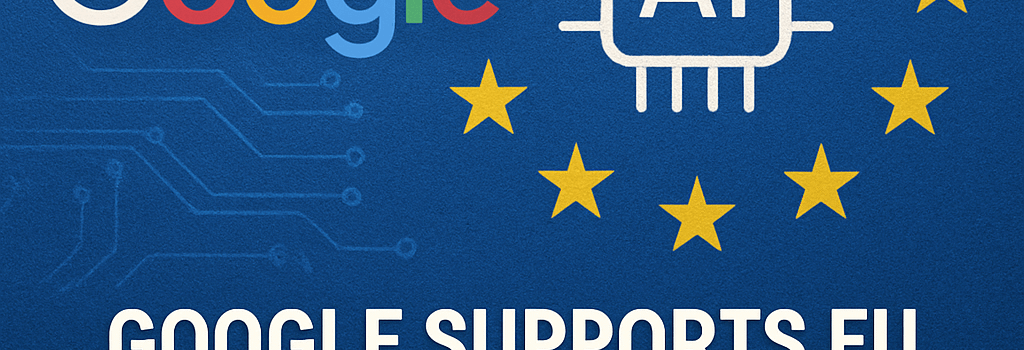Google Supports EU AI Code, Balancing Regulation and Innovation

Google has officially confirmed it will sign the European Union’s voluntary AI Code of Practice, a comprehensive framework designed to govern AI development, deployment, and transparency across member states. This decision marks a significant shift from Google’s initial objections, reflecting the company’s strategy to stay aligned with Europe’s rigorous regulatory landscape while safeguarding its capacity for innovation.
Background and Strategic Context
After months of consultations, Google’s Head of Global Affairs, Kent Walker, announced that feedback provided by Google engineers and policy experts was incorporated into the final draft of the Code. Google had earlier warned that overly rigid rules could hamper research on large language models (LLMs) such as its PaLM family and MUM (Multitask Unified Model), which range from 8 to 540 billion parameters.
“We believe this Code can deliver secure, first-rate AI tools while upholding Europe’s values,” Walker said, emphasizing the potential for an 8% GDP boost, equivalent to €1.8 trillion annually by 2034 according to internal economic models.
Key Provisions of the EU AI Code
- Transparency Requirements: Summaries of training datasets, data lineage, and annotation processes must be published.
- Safety & Security: Guidelines for adversarial testing, red-team exercises, and secure enclave usage (e.g., Intel SGX) to mitigate model vulnerabilities.
- Intellectual Property Alignment: Mechanisms for complying with EU copyright law, including APIs for rights-holder opt-outs and differential privacy techniques.
- Governance & Audit: Third-party audits, MLOps pipeline documentation, and incident-reporting protocols under the AI Act’s enforcement regime.
Technical Implications for Model Development
Under the Code, Google must publish high-level architecture diagrams for new models, document compute footprints (TPU v4 usage, GPU clusters), and outline hyperparameter tuning strategies. This level of technical granularity—unprecedented in voluntary frameworks—aims to accelerate best practices in the AI community:
- Benchmark Reporting: Model performance on benchmarks like superGLUE, WMT translation tasks, and proprietary safety tests.
- Compute Efficiency Metrics: FLOPs per token, carbon emissions per training run, and utilization rates of dynamic parallelism.
- Explainability Tools: Integration of SHAP, LIME, and custom interpretability layers within Transformer architectures.
Data Governance and Privacy
One of Europe’s core concerns is adherence to the GDPR and emerging regulations around biometric data. The Code requires Google to:
- Implement differential privacy thresholds for user-derived datasets.
- Enable encrypted model snapshots to preserve intellectual property while allowing regulators to inspect training artifacts.
- Adopt federated learning pilots in sectors like healthcare and finance under EU health data space guidelines.
Experts such as Dr. Helena Bernstein from Stanford’s Center for AI Safety warn that these measures, if overly prescriptive, could slow down innovation cycles—particularly for open-source contributions in the Hugging Face ecosystem.
Competitive Landscape and Market Dynamics
Google’s commitment contrasts with Meta’s refusal to sign, citing concerns that the Code would restrict “frontier” research on systems analogous to its hypothetical “Galileo” model, rumored to exceed 1 trillion parameters. Microsoft remains non-committal, while OpenAI has signaled its intention to comply.
Analysts at Gartner forecast that by 2027, 60% of large enterprises will select cloud AI services based on compliance credentials. Google Cloud’s Vertex AI and Microsoft Azure AI Studio are already integrating compliance dashboards to streamline AI Act adherence.
Economic and Innovation Impact
Google’s internal projections, corroborated by a study from IDC, suggest a potential uplift of €800 billion in digital services by 2028 if the Code accelerates cross-border AI adoption. Sectors expected to benefit most include automotive (autonomous driving simulation), pharmaceuticals (in silico screening), and retail (personalization engines).
Next Steps and Implementation Timeline
Signing the Code triggers a 12-month roadmap for incremental compliance. Key milestones include:
- Q4 2025: Publication of initial dataset registers and model fact sheets.
- Q2 2026: Third-party audits and security certification under ISO/IEC 42001.
- Q1 2027: Full AI Act alignment, including high-risk system registrations with the European AI Office.
Conclusion
By endorsing the EU AI Code of Practice, Google secures a proactive role in shaping AI regulation in Europe. While concerns remain over intellectual property and innovation pace, the move positions Google as a partner to regulators rather than an adversary—a critical edge in a market that accounted for 20% of its global ad and cloud revenue last year.